| Quick Links | |
|
PCMMC : Perception-Driven Coordinated Multi-Robot Motion Control Project |
|
| With support from | |
|
|
|
ISePorto Team robots have been designed entirely by LSA/ISEP. The robotics team has both a R&D and Education roles. In terms of research it is used to develop and test various areas such as distributed control and navigation, sensor fusion, hybrid systems control, robot control architectures, embedded systems concepts and distributed cooperative control techniques.
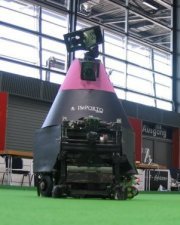
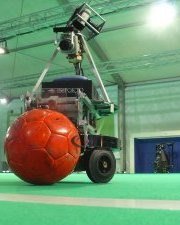
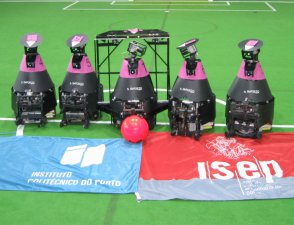
The team also supports educational courses, curricular and extra-curricular projects. Namely in the areas of embedded systems development, hardware and software design and the promotion of interdisciplinary capabilities development in the students. With high degree of actractiveness in the student comunity, the mobile robot can be an execellent experimentation platform and complementing education programs with "learn by pratice" methods.
The robots where designed and build entirely from scratch thus allowing the integration of research and educational ectivities in various disciplines.
Mechanical Design
In terms of mechanical design a diferential drive locomotion scheme was choosed along with a rotating ball kicking mechanism. This locomotion option is closer to other standard wheel based land robots and in particular is also easily applied in outdoor scenarios (where the more common omnidirectional wheel based robots have more problems). It provides aditional restricions in terms of robot manouverability thus fostering research in non-holonomic control research and its application in a competitive scenario as Robocup.~
An omni-directional locomotion scheme was not considered due to its low traction efficiency that strongly limits its application to very regular surfaces such as indoors.
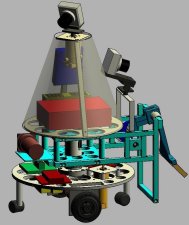 The additional degree of freedom provided by the kicker allows complex playing behaviors and pose interesting research problems. It can intercept the ball smoothly (with the vehicle moving in one direction and the kicker simultaneously moving to control the ball without griping). There is the possibility of resolving ball deadlocks by the use of the kicker extra manoeuvrability. It can intercept the ball smoothly, rotate around the ball, resolve ball deadlocks, pass and shoot in diferent different directions The mechanical kicker design also allows the execution of different pass and shot movements. This is accomplished by kicking the ball in different positions with small impulse in full contact and strong kicks by letting the ball move some space away from the robot before kicking. The kicker is connected to a structure that rotates around central axle. This axle serves and the main support for the top module that is fixed with the base. The system is mechanically modular, being possible to use the robot in different configurations, and in particular, different kicker designs can be used with the same base
The additional degree of freedom provided by the kicker allows complex playing behaviors and pose interesting research problems. It can intercept the ball smoothly (with the vehicle moving in one direction and the kicker simultaneously moving to control the ball without griping). There is the possibility of resolving ball deadlocks by the use of the kicker extra manoeuvrability. It can intercept the ball smoothly, rotate around the ball, resolve ball deadlocks, pass and shoot in diferent different directions The mechanical kicker design also allows the execution of different pass and shot movements. This is accomplished by kicking the ball in different positions with small impulse in full contact and strong kicks by letting the ball move some space away from the robot before kicking. The kicker is connected to a structure that rotates around central axle. This axle serves and the main support for the top module that is fixed with the base. The system is mechanically modular, being possible to use the robot in different configurations, and in particular, different kicker designs can be used with the same base
The robot complying with the Robocup MSL rules, is built on an aluminum circular base with a rotating superior section enclosing the on board computer, wireless comunications and kicker device. On the bottom section are the batteries, driving motors, rotating section control motor and energy management and motor control electronics.
Computational System and Communications
The robot main computer box is based on a standard SBC (Single Board Computer) with various configurations:
- Pentium III at 1.2 Ghz based SBC
- VIA C7 from 1GHz to 2 GHz clock settings
A compact flash card is used as on board solid state memory housing the file system.
The on-board computer comunicates with various sensors, axis traction control nodes and energy management electronic through a CAN bus network.
An wireless ethernet 802.11a card (in the 5Ghz spectrum) is used for robot comunications. Both inter robot coordination and in-game telemetry and game control by the referee box use the standard wifi ethernet.
The onboard embedded computer runs a Linux operating system from the flash disk. For development convenience, we use a root filesystem over NFS. A specific distribution was developed for the vehicles and a standard Linux kernel was modified in order to provide some real-time functionalities and additional development tool support. These modifications include the following patches: high resolution clocks, pre-emptive kernel and Linux Trace Toolkit support. The software design follows a modular and hierarchic multi-threaded software architecture. We use the Posix soft real time extensions: a priority pre-emptive scheduler and all the application memory resources are prevented from swapping to disk with mlock. The robots use developed software API for communication by IP datagrams in a broadcast or multicast configuration.
Traction control
 An embedded axis control board was developed with on board processing in a dedicated DSP, CAN bus interface comunications and the possibility of integrated power drive electronics (when appropriate power DC motors are available) or external power drive electronics for higher power motor requirements.
An embedded axis control board was developed with on board processing in a dedicated DSP, CAN bus interface comunications and the possibility of integrated power drive electronics (when appropriate power DC motors are available) or external power drive electronics for higher power motor requirements.
This system implements advanced on board axis control algorithms and with the possibility of measuring motor electrical current also integrates in the robot traction control architecture.
This system is used in the control of the motion for the 5 DOF of the robot (traction, rotating kicker, camera and kicking device). The CAN bus based network allows a convenient placement in the robot allong with excellent noise imunity characteristics.
The motion control system is also applied in other LSA's robot systems.
Vision system
A directional based vision system is used in the ISePorto robots. The lab research results in the LSAVision robot artificial vision architecture is incorporated. The option towards directional vision sensors and cameras has a twofold objective: general purpose application and high degree of resolution for long distance images. The vision system is not developed only for robotic soccer thus has a much wider application to robotic and order applications. In particular similar algorithms and approaches are used in very different contexts such as aerial and marine robots (as the FALCOS and ROAZ robots).
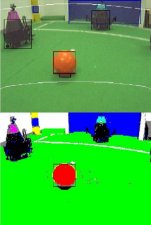 The main design consideration was not to developed robot football specific research but to use the scenario as a meaninful benchmark and testing platform. In addition with the increasing movement towards increasing field size, and possibly outoor plaiying directional vision is much more closer with the standard human vision system, and has the possibility of higher degree of spatial reoslution. This compared with omnidirectional schemes is achieved with lesser space coverture, thus the mounting of cameras in rotating mechanisms. Also the unavailability of global world (in soccer whole field) images induces research in sensor fusion and advanced navigation with results applied to other autonomous systems.
The main design consideration was not to developed robot football specific research but to use the scenario as a meaninful benchmark and testing platform. In addition with the increasing movement towards increasing field size, and possibly outoor plaiying directional vision is much more closer with the standard human vision system, and has the possibility of higher degree of spatial reoslution. This compared with omnidirectional schemes is achieved with lesser space coverture, thus the mounting of cameras in rotating mechanisms. Also the unavailability of global world (in soccer whole field) images induces research in sensor fusion and advanced navigation with results applied to other autonomous systems.
Standard USB cameras with custom lenses are used allong with special developed vision sensor BoaVista. This smart camera was developed at LSA to perform part of the image processing and clasisification in dedicated hardware thus reducing information bandwidth and increasing the information abstraction.
One of the cameras has a pan mount and the other is fixed with the kicking device. Both cameras are used for navigation, obstacle detection and ball control.
Control and navigation
The control and navigation architecture is designed in a hybrid systems framework. Networks of hybrid automata represent and organize the robots behavior (either individually or in teams) and functionalities. The hybrid systems framework allows the description of the continuous processes involved (in control and sensing) and the conjunction with the discrete nature of occurring events and underlying decision processes. A relevant aspect of the system organization is the simultaneous consideration of control and navigation in the design process. By integrating the navigation and control in the maneuver design, significant additional advantages, such as a better sensor and actuator management (resolving many sensory conflicting requirements) and the availability of adequate sensory and navigation information for the control maneuver in execution, are obtained. Thus, specific navigation algorithms and sensor configuration can be optimized for each situation. One example in the robotic soccer context are the robot maneuvers to simultaneously attack the adversary goalie, maintaining good landmark line of sight for vision navigation purposes, and tracking targets that can interact with the vehicles action. The coordinated maneuvers organize the vehicles in hierarchical clusters according with their spatial configuration or other relevant features. While lower level clusters have high interaction in control and navigation, higher level ones are loosely coupled and, thus, their communication requirements are less strict.


